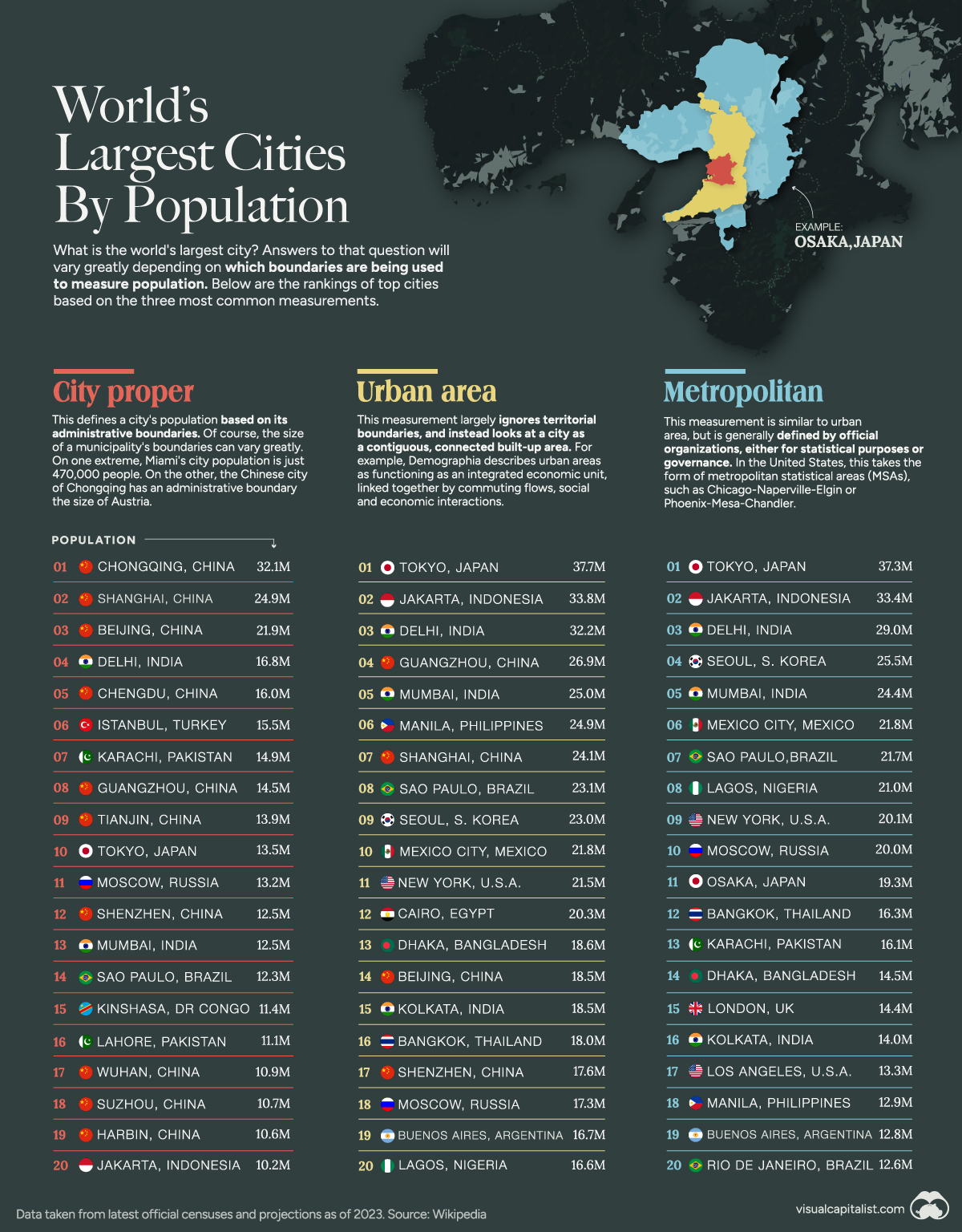The Urban Transformation: Unveiling The Top Largest Cities In The World

Categories :
Chongqing, Shanghai, Beijing, Tokyo, Delhi, Jakarta, Seoul….. The rise in urbanisation is causing a demographic shift in paradigms. This article provides a comprehensive analysis of the world's largest cities, based on a study carried out by Visual Capitalist.

The United Nations forecasts that by 2030, “urban areas are projected to house 60 percent of people globally and one in every three people will live in cities with at least half a million inhabitants”.
Since cities are the hubs of commerce, governance, mobility, and innovation and smart systems, they tend to grow in both size and number. Speaking as of 2023, the world’s 20 largest cities, like Shanghai, Tokyo, Beijing, Jakarta, New Delhi, São Paulo, and Mexico City, are home to more than 4.3 billion people. This means, more than 55% of the world population lives in urban settings.
According to a recent study by Visual Capitalist, here are the top 20 megacities in the world in 2023, each under three metrics: City Proper, Urban Area, and Metropolitan.
Chongqing, Shanghai, Beijing: China leads the ‘City Proper’ metric
The United Nations defines the term 'City Proper' as:
"a single political jurisdiction which contains the historical city centre."
This metric delves into the population residing within a city's administrative boundaries, providing insights into its core demographic composition. The City Proper metric provides a standardized way of comparing cities across the globe, enabling us to gauge the growth and density of urban populations in a consistent manner. This approach is particularly valuable in comprehending the unique challenges and opportunities that arise within the heart of a city, making it an indispensable component in our efforts to comprehend the ever-evolving urban landscape.
Leading this category is Chongqing, China, home to an urban population of 32.1 million. Chongqing boasts an administrative boundary larger than Austria, and its monorail system spans 70 stations.
As we delve further into this metric, the dominance of Chinese cities becomes evident, showcasing the nation's remarkable journey of urban growth and development. Among the notable names that follow in this trajectory are Shanghai, Beijing, New Delhi, Chengdu, Istanbul, Karachi, Guangzhou, Tianjin, and Tokyo. These cities form a constellation of urban centers, each contributing uniquely to the narrative of urbanization and its ever-evolving dynamics.
With Chongqing, Shanghai, Beijing, Chengdu, Guangzhou, Tianjin, Shenzhen, Wuhan, Suzhou, and Harbin, China has the most number of largest cities, according to the City Proper metric.
Istanbul takes the 6th position with one part of the city lying in Europe and the other part in Asia and housing a population of 15.5 million. Kinshasa (Dr Congo) is ranked at 15th position with 11.4 million population.
And among this constellation, Delhi is the first non-Chinese city on the list at the fourth position, experiencing rapid urban growth. By 2050, India is projected to add over 400 million urban dwellers, surpassing China and Nigeria's urban expansion.

Tokyo, Jakarta, Delhi: Largest cities by ‘Urban Area’
This metric focuses on urban areas without being restricted by specific territorial boundaries. It highlights the sheer size and population density of these interconnected urban clusters.
The Urban Area metric provides insights into the functional integration of economic, social, and commuting flows within these expansive cityscapes, shedding light on the complex relationships that shape urban life. This approach is essential for capturing the holistic essence of a city's influence and reach, enabling us to appreciate the interconnectedness of urban environments on a global scale.
For instance, Tokyo stands as a prominent example with a staggering 37.7 million people living in its expansive urban area.
Tokyo's urban area encapsulates not just the city itself but also extends its influence to encompass adjacent regions. This intricate urban fabric forms a vital economic unit, interwoven through bustling commuting flows, thriving social interactions, and dynamic economic exchanges. Tokyo's vast urban expanse, with its web of interconnected districts and neighbourhoods, exemplifies the ever-evolving nature of modern metropolises. In a city where innovation and tradition converge, this urban area reflects both the challenges and opportunities of accommodating a population that comprises a significant portion of the nation's populace. As Tokyo continues to evolve, its urban landscape serves as a canvas for the intricate dance of urban planning, development, and the pursuit of a harmonious urban lifestyle.
Jakarta, Delhi, and Guangzhou follow suit, each boasting populations of 33.8 million, 32.2 million, and 26.9 million respectively, showcasing the remarkable concentrations of people within these cityscapes.
While 4 out of the largest 20 cities according to Urban Area are from China, three of them are from India: New Delhi, Mumbai, and Kolkata. Other Asian cities in the list include: Manila (Philippines), Seoul (S. Korea), Dhaka (Bangladesh), Bangkok (Thailand), and Moscow Russia.
The largest city in the American continent is Sao Paulo in Brazil with 23.1 million people, followed by Mexico City (21.8 million), and Buenos Aires in Argentina with 16.7 million people.
Largest cities by metropolitan
Similar to urban area metrics, metropolitan areas are defined officially for statistical or governance purposes. Metropolitan captures the collaborative economic, social, and cultural interactions that occur within metropolitan regions, showcasing the intricate web of connections that shape urban dynamics. This approach is crucial for recognising the overarching impact of urbanisation, as it accounts for the sprawling influence that extends beyond the central city core.
Tokyo takes the lead in this category, with a substantial population of 37.3 million. Jakarta, Delhi, and Seoul follow suit with 33.4 million, 29.0 million, and 25.5 million residents respectively. Mumbai and Mexico City each house 24.4 million people, while Sao Paulo and Lagos have populations of 21.7 million and 21.0 million respectively. The list also includes New York with 20.1 million inhabitants, Los Angeles (13.3 million), Rio de Janeiro (Brasil, 12.6 million), London (14.4 million), Karachi (16.1 million), Osaka (Japan, 19.3 million) and Moscow with 20.0 million residents.
The Future of urbanisation
The phenomenon of urbanisation has dramatically reshaped the global landscape, leading to the emergence of vibrant city centres that serve as hubs of activity and innovation. Over the past century, this sweeping wave of urbanisation has been transforming both physical and social landscapes.
As cities continue to grow and evolve, the dynamics of our planet's urban fabric are undergoing a rapid and unprecedented transformation. This shift isn't just about numbers; it encompasses a complex interplay of cultural, economic, and environmental factors that are influencing the way we live, work, and interact with each other and our surroundings.
The ongoing rise of global urban populations is poised to introduce new contenders from Africa and Asia into the race for the coveted "largest city" title. A significant shift is underway as the United Nations forecasts that by 2050, nearly 70% of the world's population will call urban areas their home, solidifying urbanisation's profound and enduring impact on the trajectory of our planet.

Pallavi Singal is the Vice President of Content at ztudium, where she leads innovative content strategies and oversees the development of high-impact editorial initiatives. With a strong background in digital media and a passion for storytelling, Pallavi plays a pivotal role in scaling the content operations for ztudium’s platforms, including Businessabc, Citiesabc, and IntelligentHQ, Wisdomia.ai, MStores, and many others. Her expertise spans content creation, SEO, and digital marketing, driving engagement and growth across multiple channels. Pallavi’s work is characterised by a keen insight into emerging trends in business, technologies like AI, blockchain, metaverse and others, and society, making her a trusted voice in the industry.










